|
|
|

Florence et Michel GUERIN |
|
The irish terrier

-
Character: Originally the irish terrier was a " farm
dog" , a « dog of dung heap» , he removed the farm
immediate surroundings of the undesirable animals and
was also the dog of the family, this explains why he
LIKES the COMPANY OF HUMAN and also domestic animals.
He has an extreme devotion with his masters and likes
them with a satisfying and a matchless fidelity, he
protects his/her children and plays with them He
adores the children but in a mutual respect because
the dog, this is similar for all breeds, will not obey
the child whom he looks as a litter buddy and not as a
small-scale model of his master, thus it is necessary
to learn to the child how he has to respect the dog
and to understand his rules.
It is a particularly gifted breed of dog for
CYNOTHERAPY (technique of care for the
children, patients, old people, their presence
friendly facilitates the care and the psychological
cure of many patients) to see definition on this site
 (in
french) Two of the irish born in our kennel
practise this discipline with success (in
french) Two of the irish born in our kennel
practise this discipline with success
He is not a gun dog, because he does not give any bark
and nobody knows where he is when he chases after his
prey, nevertheless he has a good sense of smell. Some
American breeders claim that he is a dog "for badger",
he is courageous but careful in spite of his nickname
of "daredevil.). He is a terrier, therefore a very proud
animal with a really remarkable intelligence, a "decision
maker" so it is easy to train him with gentle way
(to see metho :
gentle dog training .By
treating the dog as an intelligent being who is
frequently rewarded and
rarely punished, this complete dog training handbook
guides owners through a basic education and into a happy
relationship with their pet.
This method is perfectly appropriate to irish
terrier because dogs perceive
every gesture, movement, and even the thoughts of their
owners as training signals, this resource teaches owners
to watch their behavior as much as their dogs. With
clear authority, gentleness, and a positive attitude,
the tried and tested methods in this guide prove that it
is always possible to solve a dog's behavioral problems
without hitting or shouting. )
So he obeys to give
pleasure with his master and not constrained and forced.
He likes the exercice(to see
sport) but is satisfied to live in apartment if his
master is present, he prefers his master rather freedom!
He was also used, in times of war, to pass from a trench
to the other and also like kamikaze and carrying
explosive (not volunteer, but to like his maitre), this
was worth to him a military distinction and a monument.
- Standards
STANDARD F.C.I.:
n° 139/ 08.11.2002 / F TERRIER IRLANDAIS (Irish
Terrier).
TRANSLATION: Prof. R.
Triquet.
ORIGIN: Ireland.
PUBLICATION OF ORIGINAL : 13/03/2001.
CLASSIFICATION F.C.I.:
Group 3 - Terriers Section 1- Big and medium size Terriers.
USE: Farm Dog to to do everything, pet dog, watchdog
showing the greatest contempt for the danger and the
wounds, dog of hunt and with shooting.
Without test of work.
|
|
SHORT
INSIGHT HISTORIC: Ireland produced four races of
terriers and all are definitely different from the
terrier of the continent and England. It is possible
that the dog which currently carries, in an official way,
the name of Irish Terrier, is the oldest terrier of
Ireland, but there is so few authenticated facts which
it would be difficult to bring a final proof.
Before
the years 1880, the color of the Irish Terrier was not
fixed. In addition to the red coat, there were sometimes
blacks and fire and sometimes of brindling. At the end
of the 19th century, one endeavoured to eliminate from
the breeding the blacks and fire and brindle, so that at
the 20th century, all the Irish Terriers wore the red
coat.
These
Irish Terrier with red dress made their appearance in
the dogshow of England and United States where they were
accomodated with enthusiasm. Their reputation still
increased during the First World War, where they were
used with the transmission of the messages in the
terrifying noise and the confusion of the war of the
trenches.
Then
they gave the proof of their intelligence and their
intrepidity. The first club of the race was created in
Dublin on March 31, 1879 and the Irish Terrier was the
first of the terrier group in Ireland to being
recognized by Kennel Club English, at the end of the
19th century, as a race of Irish origin. The reputation
of this dog to brawl with others including sometimes in
the show ring is unjustified.
Although this terrier can be ardent when the
circumstances require it, the Irish terrier is educated
easily and he is a sweet companion as description given
at the beginning: "sentinel of poor, friend of the
framer, favourite of the man of quality".
|
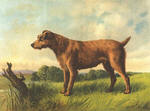
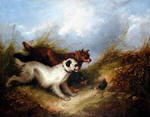
 |
|

General
Appearance
An active, lively and wiry appearance; plenty of
substance but free of clumsiness. Neither cloddy nor
cobby but showing a graceful racy outline.
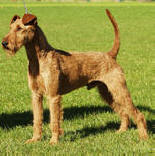

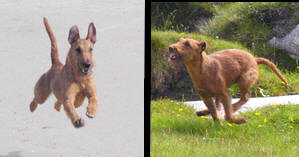 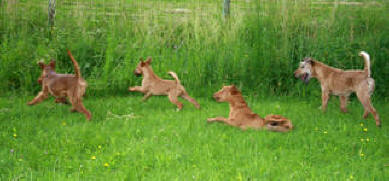
Characteristics
There is a heedless, reckless pluck about the Irish
Terrier which is characteristic, and, coupled with the
headlong dash, blind to all consequences, with which he
rushes at his adversary, has earned for the breed the
proud epithet of ‘the Daredevils’. When ‘off duty’ they
are characterised by a quiet caress-inviting appearance,
and when one sees them endearingly, timidly pushing
their heads into their master’s hands, it is difficult
to realise that on occasions, at the ‘set on’, they can
prove that they have the courage of a lion, and will
fight to the last breath in their bodies. They develop
an extraordinary devotion for and have been known to
track their masters almost incredible distances
Temperament
Good-tempered, notably with humans, it being admitted,
however, that he is perhaps a little too ready to resent
interference on the part of other dogs.
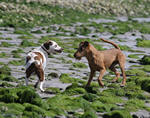
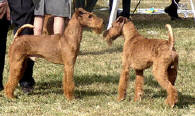

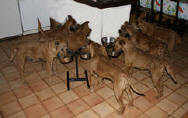


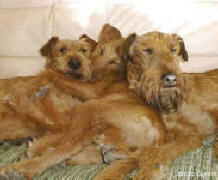

|
|

Head and
Skull
Head long; skull flat, and rather narrow between ears,
narrowing towards eye; free from wrinkles; stop hardly
visible except in profile. Jaw strong and muscular, but
not too full in cheek, and of good length. Foreface not
dished or falling away quickly between eyes, delicately
chiselled. Lips well fitting and externally almost black
in colour. Nose black.
Eyes
Dark, small, not prominent. A light or yellow eye highly
undesirable.
Ears
Small and V-shaped, of moderate thickness, set well on
head, and dropping forward closely to cheek. Top of
folded ear well above level of skull. Ear must be free
of fringe, and hair thereon shorter and darker in colour
than body.
Mouth
Teeth even, strong and free from discoloration. Jaws
strong, with perfect, regular scissor bite, i.e. upper
teeth closely overlapping lower teeth and set square to
the jaws.

Neck
Fair length and gradually widening towards shoulders,
well carried and free of throatiness. Generally a slight
fringe at each side of neck, running nearly to corner of
ear.
|

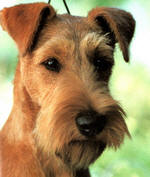
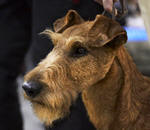
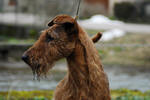 |
|

Body
Chest deep and muscular, neither full nor wide. Body
moderately long; back strong and straight, with no
appearance of slackness behind shoulders; loin muscular
and slightly arched; ribs fairly sprung, rather deep
than round, and well ribbed back.
Tail
Customarily docked.
Docked: Customarily docked to about three quarters. Free
of fringe or feather, but well covered with rough hair.
Set on pretty high, carried gaily but not over back or
curled.
Undocked: Set on pretty high, carried gaily but not over
back or curled. Free of fringe or feather but well
covered with rough hair. In overall balance with the
rest of the dog. Carriage is such that the tail is not
liable to damage during working.
|
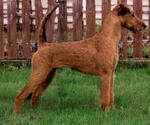
 |
|

Forequarters
Shoulders fine, long and well laid back. Legs moderately
long, well set from shoulders, perfectly straight, with
plenty of bone and muscle; elbows working freely clear
of sides; pasterns short and straight, hardly
noticeable, the forelegs moved straightforward when
travelling.
Body
Chest deep and muscular, neither full nor wide. Body
moderately long; back strong and straight, with no
appearance of slackness behind shoulders; loin muscular
and slightly arched; ribs fairly sprung, rather deep
than round, and well ribbed back.
Hindquarters
Strong and muscular, thighs powerful, hocks well let
down, stifles moderately bent. Hindlegs move straight
forward when travelling, hocks not turned outwards. Hair
on legs dense and crisp.
Feet
Strong, tolerably round, moderately small, toes arched,
neither turned out nor in; black toe nails most
desirable. Pads sound and free from cracks or horny
excrescences.
|
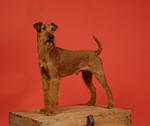
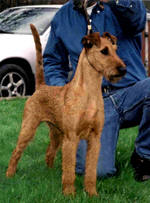 |
|

Gait/Movement
Fore- and hindlegs carried straight forward and
parallel. Elbows move perpendicular to body, working
free of sides, stifles neither turning in nor out.
|
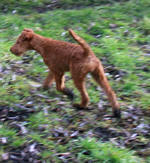
 |
|

Coat
Harsh and wiry, having broken appearance, free of
softness or silkiness, not so long as to hide the
outline of body particularly in hindquarters, straight
and flat, no shagginess and free of lock or curl. At
base of these stiff hairs is growth of finer and softer
hair, usually termed the undercoat. Hair on foreface
crisp and only sufficiently long to impart appearance of
additional strength. Hair on legs dense and crisp.
Colour
‘Whole-coloured’, most preferable colours being red,
red/wheaten, or yellow/red. Small amount of white on
chest acceptable, white on feet highly undesirable.
Black shading highly undesirable.
|
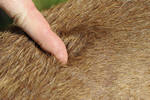
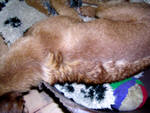
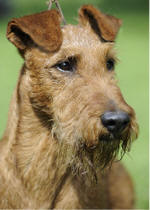
|
|

Size
Ideal height: dogs: 48 cms (19 ins); bitches: 46 cms (18
ins).
Faults
Any departure from the foregoing points should be
considered a fault and the seriousness with which the
fault should be regarded should be in exact proportion
to its degree and its effect upon the health and welfare
of the dog.
Note
Male animals should have two apparently normal testicles
fully descended into the scrotum.
|
|
|
|
|
|

Standard américain:
Breed Standard
Head
Long, but in nice proportion to the rest of the body;
the skull flat, rather narrow between the ears, and
narrowing slightly toward the eyes; free from wrinkle,
with the stop hardly noticeable except in profile. The
jaws must be strong and muscular, but not too full in
the cheek, and of good punishing length. The foreface
must not fall away appreciably between or below the
eyes; instead, the modeling should be delicate. An
exaggerated foreface, or a noticeably short foreface,
disturbs the proper balance of the head and is not
desirable. The foreface and the skull from occiput to
stop should be approximately equal in length. Excessive
muscular development of the cheeks, or bony development
of the temples, conditions which are described by the
fancier as "cheeky," or "strong in head," or "thick in
skull" are objectionable. The "bumpy" head, in which the
skull presents two lumps of bony structure above the
eyes, is to be faulted. The hair on the upper and lower
jaws should be similar in quality and texture to that on
the body, and of sufficient length to present an
appearance of additional strength and finish to the
foreface. Either the profuse, goat-like beard, or the
absence of beard, is unsightly and undesirable.
Teeth
Should be strong and even, white and sound; and neither
overshot nor undershot.
Lips
Should be close and well-fitting, almost black in color.
Nose
Must be black.
Eyes
Dark brown in color; small, not prominent; full of life,
fire and intelligence, showing an intense expression.
The light or yellow eye is most objectionable, and is a
bad fault.
Ears
Small and V-shaped; of moderate thickness; set well on
the head, and dropping forward closely toward the
outside corner of the eye. The top of the folded ear
should be well above the level of the skull. A "dead"
ear, hound-like in appearance, must be severely
penalized. It is not characteristic of the Irish
Terrier. The hair should be much shorter and somewhat
darker in color than that on the body.
Neck
Should be of fair length and gradually widening toward
the shoulders; well and proudly carried, and free from
throatiness. Generally there is a slight frill in the
hair at each side of the neck, extending almost to the
corner of the ear.
Shoulders and Chest
Shoulders must be fine, long, and sloping well into the
back. The chest should be deep and muscular, but neither
full nor wide.
Body
The body should be moderately long. The short back is
not characteristic of the Irish Terrier, and is
extremely objectionable. The back must be strong and
straight, and free from an appearance of slackness or
"dip" behind the shoulders. The loin should be strong
and muscular, and slightly arched, the ribs fairly
sprung, deep rather than round, reaching to the level of
the elbow. The bitch may be slightly longer than the
dog.
Hindquarters
Should be strong and muscular; thighs powerful; hocks
near the ground; stifles moderately bent.
Stern
Should be docked, taking off about one quarter. It
should be set on rather high, but not curled. It should
be of good strength and substance; of fair length and
well covered with harsh, rough hair.
Feet and Legs
The feet should be strong, tolerably round, and
moderately small; toes arched and turned neither out nor
in, with dark toenails. The pads should be deep, and
must be perfectly sound and free from corns. Cracks
alone do not necessarily indicate unsound feet. In fact,
all breeds have cracked pads occasionally, from various
causes.
Legs moderately long, well set from the shoulders,
perfectly straight, with plenty of bone and muscle; the
elbows working clear of the sides; pasterns short,
straight, and hardly noticeable. Both fore and hind legs
should move straight forward when traveling; the stifles
should not turn outward. "Cowhocks"--that is, the hocks
turned in and the feet turned out--are intolerable. The
legs should be free from feather and covered with hair
of similar texture to that on the body to give proper
finish to the dog.
Coat
Should be dense and wiry in texture, rich in quality,
having a broken appearance, but still lying fairly close
to the body, the hairs growing so closely and strongly
together that when parted with the fingers the skin is
hardly visible; free of softness or silkiness, and not
so long as to alter the outline of the body,
particularly in the hindquarters. On the sides of the
body the coat is never as harsh as on the back and
quarters, but it should be plentiful and of good
texture. At the base of the stiff outer coat there
should be a growth of finer and softer hair, lighter in
color, termed the undercoat. Single coats, which are
without any undercoat, and wavy coats are undesirable;
the curly and the kinky coats are most objectionable.
Color
Should be whole-colored: bright red, golden red, red
wheaten, or wheaten. A small patch of white on the
chest, frequently encountered in all whole-colored
breeds, is permissible but not desirable. White on any
other part of the body is most objectionable. Puppies
sometimes have black hair at birth, which should
disappear before they are full grown.
Size
The most desirable weight in show condition is 27 pounds
for the dog and 25 pounds for the bitch. The height at
the shoulder should be approximately 18 inches. These
figures serve as a guide to both breeder and judge. In
the show ring, however, the informed judge readily
identifies the oversized or undersized Irish Terrier by
its conformation and general appearance. Weight is not
the last word in judgment. It is of the greatest
importance to select, insofar as possible, terriers of
moderate and generally accepted size, possessing the
other various characteristics.
General Appearance
The over-all appearance of the Irish Terrier is
important. In conformation he must be more than a sum of
his parts. He must be all-of-a piece, a balanced vital
picture of symmetry, proportion and harmony.
Furthermore, he must convey character. This terrier must
be active, lithe and wiry in movement, with great
animation; sturdy and strong in substance and bone
structure, but at the same time free from clumsiness,
for speed, power and endurance are most essential. The
Irish Terrier must be neither "cobby" nor "cloddy," but
should be built on lines of speed with a graceful,
racing outline.
Temperament
The temperament of the Irish Terrier reflects his early
background: he was family pet, guard dog, and hunter. He
is good tempered, spirited and game. It is of the utmost
importance that the Irish Terrier show fire and
animation. There is a heedless, reckless pluck about the
Irish Terrier which is characteristic, and which,
coupled with the headlong dash, blind to all
consequences, with which he rushes at his adversary, has
earned for the breed the proud epithet of "Daredevil."
He is of good temper, most affectionate, and absolutely
loyal to mankind. Tender and forebearing with those he
loves, this rugged, stout-hearted terrier will guard his
master, his mistress and children with utter contempt
for danger or hurt. His life is one continuous and eager
offering of loyal and faithful companionship and
devotion. He is ever on guard, and stands between his
home and all that threatens.
Approved December 10, 1968
|
|
 |
|